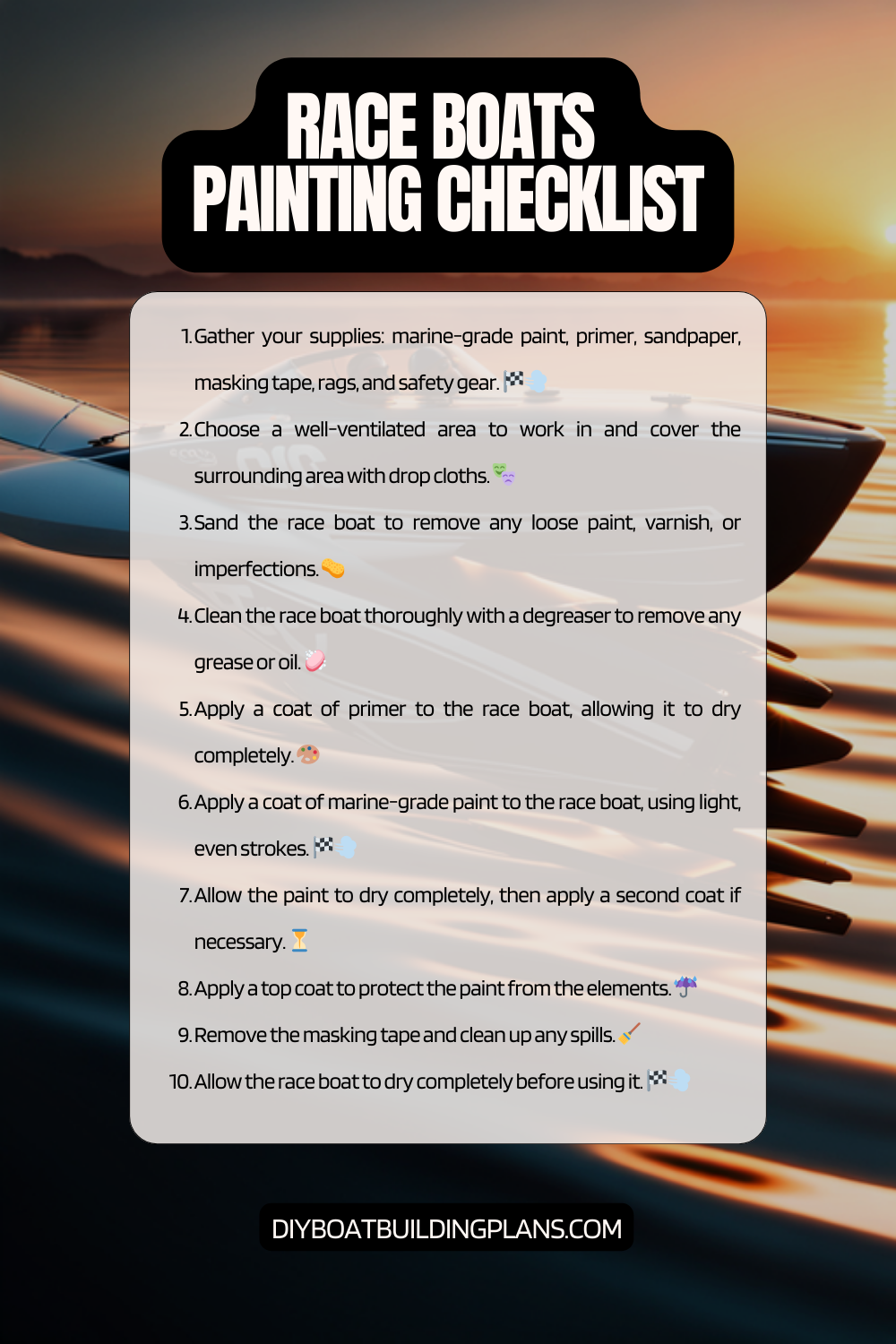Overview of Race Boat Painting Tips
A well-painted race boat is not only aesthetically pleasing but also crucial for its performance on the water. The paint not only enhances the boat’s appearance but also protects it from the harsh marine environment, including saltwater, UV rays, and general wear and tear. A properly painted race boat can also improve its speed and maneuverability by reducing drag and improving hydrodynamics. Therefore, investing time and effort into a high-quality paint job is essential for any serious racer.
The process of painting a race boat involves several steps, starting from choosing the right paint to applying graphics and logos. Each step requires careful consideration and attention to detail to achieve a professional-looking finish. In this article, we will explore the various aspects of race boat painting, including choosing the right paint, preparing the surface, sanding techniques, masking and taping, application methods, maintenance tips, and common mistakes to avoid.
Key Takeaways
- Choose the right paint for your race boat to ensure durability and performance.
- Proper preparation, including sanding and masking, is crucial for a smooth and clean paint job.
- Spraying is generally preferred over brushing for a professional-looking finish.
- Applying graphics and logos can add a personal touch to your race boat.
- Avoid common mistakes such as rushing the process or neglecting proper ventilation.

Choosing the Right Paint for Your Race Boat
When it comes to choosing paint for your race boat, there are several options available in the market. The two main types of paint commonly used are one-part polyurethane and two-part polyurethane. One-part polyurethane paints are easier to apply and require less preparation but may not provide as durable a finish as two-part polyurethane paints. Two-part polyurethane paints offer superior durability and resistance to fading, chemicals, and abrasion but require more meticulous preparation and application.
Factors to consider when choosing paint include the boat’s usage, environmental conditions it will be exposed to, desired finish (glossy or matte), color options, and budget. It is advisable to consult with professionals or experienced racers who can provide guidance based on their expertise and personal experiences.
Preparing Your Race Boat for Painting
Before applying any paint to your race boat, proper surface preparation is crucial for achieving a smooth and long-lasting finish. The first step is to thoroughly clean and degrease the boat’s surface to remove any dirt, grime, or contaminants. This can be done using a mild detergent or specialized boat cleaning products. It is important to ensure that the surface is completely clean and dry before proceeding to the next step.
Next, inspect the boat for any damage or imperfections such as scratches, dents, or cracks. These should be repaired using appropriate fillers, sealants, or fiberglass repair kits. It is essential to address these issues before painting to ensure a flawless final result.
Once the repairs are complete, the surface should be primed to provide a suitable base for the paint. Priming helps improve adhesion, enhances color uniformity, and provides additional protection against corrosion. Choose a primer specifically designed for marine applications and follow the manufacturer’s instructions for proper application.
Sanding Techniques for a Smooth Finish
| Technique | Description | Advantages | Disadvantages |
| Hand Sanding | Sanding by hand using sandpaper or sanding blocks. | Controlled sanding, good for small areas, inexpensive. | Time-consuming, inconsistent results, can cause fatigue. |
| Power Sanding | Sanding using power tools such as orbital sanders or belt sanders. | Efficient, consistent results, good for large areas. | Expensive, can cause damage if not used properly, noisy. |
| Wet Sanding | Sanding using water to lubricate the surface and prevent dust. | Smooth finish, reduces dust, good for finishing coats. | Messy, requires more time and effort, can cause rust if not dried properly. |
| Buffing | Using a buffing wheel or pad to polish the surface. | High gloss finish, removes scratches and imperfections. | Requires special equipment, can be expensive, can cause heat damage if not used properly. |
Sanding plays a crucial role in achieving a smooth and flawless finish on your race boat. It helps remove any remaining imperfections, roughens the surface for better paint adhesion, and creates a uniform texture. There are different types of sandpaper available, ranging from coarse to fine grits. The choice of sandpaper depends on the condition of the surface and the desired level of smoothness.
Start with a coarser grit sandpaper to remove any rough areas or imperfections. Gradually progress to finer grits to achieve a smoother finish. It is important to sand in a consistent direction and avoid applying excessive pressure, as this can damage the surface. Use a sanding block or sanding machine for larger areas to ensure even pressure distribution.
After sanding, thoroughly clean the surface to remove any dust or debris before proceeding with painting. A tack cloth or lint-free cloth can be used for this purpose.
Masking and Taping for Clean Lines
Masking and taping are essential steps in achieving clean lines and preventing overspray or paint bleed. Proper masking ensures that only the intended areas are painted, while protecting other parts of the boat from accidental paint application.
There are different types of tape available for masking, including painter’s tape, masking tape, and automotive-grade tapes. Painter’s tape is commonly used as it provides good adhesion and can be easily removed without leaving residue or damaging the surface. It is important to choose a tape suitable for the surface being masked and follow the manufacturer’s instructions for proper application.
When masking, take your time to ensure precise lines and edges. Use a plastic or metal straight edge to guide the tape placement for straight lines. For curved or irregular shapes, use smaller pieces of tape and overlap them slightly to create a seamless transition.
Spraying vs. Brushing: Which Method is Best?
The method of paint application can significantly impact the final result of your race boat’s paint job. The two main methods commonly used are spraying and brushing. Each method has its pros and cons, and the choice depends on various factors such as personal preference, desired finish, type of paint used, and available equipment.
Spraying offers several advantages, including faster application, smoother finish, and better coverage on large surfaces. It allows for more control over the thickness of the paint layer and can achieve a professional-looking result with minimal brush strokes or texture. However, spraying requires specialized equipment such as spray guns or airbrushes and may not be suitable for small or intricate areas.
Brushing, on the other hand, is a more traditional method that requires less equipment and can be easily done by beginners. It allows for better control over paint application in tight spaces or areas that are difficult to reach with a spray gun. However, brushing may result in visible brush strokes or texture on the surface, requiring additional sanding or polishing to achieve a smooth finish.
Consider the size and complexity of your race boat, the type of paint being used, and your level of experience when deciding which method to use. It is also worth noting that a combination of both methods can be employed, using spraying for larger areas and brushing for smaller details.
Tips for Achieving a Professional-Looking Paint Job
To achieve a professional-looking paint job on your race boat, it is important to follow proper application techniques and pay attention to detail. Here are some tips to help you achieve the best results:
1. Prepare the surface thoroughly: Proper surface preparation is crucial for a flawless finish. Clean, repair, and prime the surface as discussed earlier.
2. Use the right tools and equipment: Invest in high-quality brushes, rollers, or spray guns suitable for the type of paint being used. Using the right tools can make a significant difference in the final result.
3. Apply thin coats: It is better to apply multiple thin coats rather than one thick coat. Thin coats dry faster, adhere better, and minimize the risk of runs or drips.
4. Maintain consistent pressure and speed: Whether brushing or spraying, maintain consistent pressure and speed throughout the application process to achieve an even finish.
5. Allow proper drying and curing time: Follow the manufacturer’s instructions regarding drying and curing times between coats. Rushing this process can lead to poor adhesion or premature damage.
6. Pay attention to environmental conditions: Avoid painting in extreme temperatures or high humidity, as these can affect the paint’s performance and drying time.
7. Practice patience: Achieving a professional-looking paint job takes time and patience. Take breaks when needed, step back to assess your progress, and make any necessary adjustments before proceeding.
Applying Graphics and Logos to Your Race Boat
Applying graphics and logos to your race boat not only adds a personal touch but also helps with branding and recognition on the water. Before applying any graphics, ensure that the base paint is fully cured and properly prepared.
There are different methods for applying graphics, including vinyl decals, stencils, or freehand painting. Vinyl decals are a popular choice as they are easy to apply, come in various designs and colors, and can be easily removed or replaced if needed. Stencils can be used for more intricate designs or custom logos, allowing for precise placement and control over the paint application. Freehand painting requires more skill and practice but offers the most flexibility for unique designs.
When applying graphics, take your time to ensure proper alignment and smooth application. Use a squeegee or credit card to remove any air bubbles or wrinkles. If using stencils, secure them firmly in place and apply the paint evenly using a brush or spray gun. Allow the graphics to dry completely before applying any protective clear coat.
Download over 500 Boat Plans. Click on the link below.
-->Click Here<--
Maintaining Your Race Boat’s Paint Job
Proper maintenance is essential for keeping your race boat’s paint job looking new and protecting it from the harsh marine environment. Here are some tips to help you maintain your paint job:
1. Regular cleaning: Wash your boat regularly with mild soap or specialized boat cleaners to remove salt, dirt, and other contaminants. Avoid using abrasive cleaners or brushes that can damage the paint.
2. Waxing: Apply a high-quality marine wax to protect the paint from UV rays, oxidation, and fading. Waxing also helps repel water and reduce staining.
3. Avoid harsh chemicals: Avoid using harsh chemicals or solvents that can damage the paint or strip away protective coatings. Use gentle cleaners specifically designed for marine applications.
4. Touch-ups: Keep a small supply of touch-up paint for minor scratches or chips. Promptly address any damage to prevent further deterioration.
5. Store properly: When not in use, store your race boat in a covered area or use a boat cover to protect it from the elements. UV exposure, extreme temperatures, and moisture can all damage the paint over time.
6. Regular inspections: Periodically inspect your boat’s paint job for any signs of damage, fading, or peeling. Address any issues promptly to prevent further damage.
Common Mistakes to Avoid When Painting Your Race Boat
While painting your race boat can be a rewarding experience, there are some common mistakes that should be avoided to achieve the best results:
1. Insufficient surface preparation: Skipping or rushing through the surface preparation process can lead to poor adhesion, paint failure, or an uneven finish. Take the time to clean, repair, and prime the surface properly.
2. Inadequate masking and taping: Improper masking can result in overspray or paint bleed, leading to messy lines and a less professional-looking finish. Take your time to mask and tape carefully, ensuring precise lines and edges.
3. Rushing the application process: Applying paint too quickly or in thick coats can result in runs, drips, or uneven coverage. Follow the manufacturer’s instructions regarding drying and curing times between coats.
4. Neglecting environmental conditions: Painting in extreme temperatures or high humidity can affect the paint’s performance and drying time. Choose suitable weather conditions for painting and allow proper ventilation.
5. Lack of patience and attention to detail: Achieving a professional-looking paint job requires patience and attention to detail. Take breaks when needed, step back to assess your progress, and make any necessary adjustments before proceeding.
Race Boat Painting Checklist

Conclusion – Race Boat Painting Tips
In conclusion, painting your race boat is not only about enhancing its appearance but also protecting it from the harsh marine environment and improving its performance on the water. Choosing the right paint, preparing the surface properly, using proper sanding techniques, masking and taping for clean lines, selecting the appropriate application method, applying graphics and logos effectively, and maintaining the paint job are all crucial steps in achieving a professional-looking finish.
While the process may seem daunting, taking the time and effort to follow these tips and techniques will result in a race boat that stands out on the water. Remember to consult with professionals or experienced racers for guidance and advice, as their expertise can be invaluable. With proper planning, preparation, and execution, you can achieve a paint job that not only looks great but also enhances your race boat’s performance and durability. So, take the plunge and embark on this exciting journey of race boat painting!
FAQs – Race Boat Painting Tips
What is race boat painting?
Race boat painting is the process of applying paint or coating to a boat used for racing purposes. The paint is applied to the boat’s exterior to enhance its appearance, protect it from the elements, and improve its performance.
What are some tips for painting a race boat?
Some tips for painting a race boat include preparing the surface properly, using high-quality paint and materials, applying the paint in thin coats, allowing sufficient drying time between coats, and using proper safety equipment.
What types of paint are suitable for race boats?
The types of paint suitable for race boats include epoxy, polyurethane, and acrylic paints. These paints are durable, resistant to water, and can withstand the harsh marine environment.
How do I prepare the surface of a race boat for painting?
To prepare the surface of a race boat for painting, you need to clean it thoroughly, remove any old paint or coatings, sand the surface to create a smooth finish, and apply a primer to help the paint adhere to the surface.
What safety precautions should I take when painting a race boat?
When painting a race boat, you should wear protective clothing, gloves, and a respirator to avoid inhaling paint fumes. You should also work in a well-ventilated area and avoid smoking or using open flames near the paint.
How long does it take to paint a race boat?
The time it takes to paint a race boat depends on the size of the boat, the type of paint used, and the number of coats applied. Generally, it can take several days to a week to complete the painting process.



